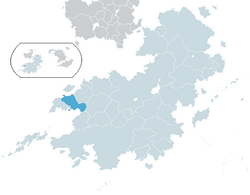Tamisari Socialist Republic
This article is incomplete because it is pending further input from participants, or it is a work-in-progress by one author. Please comment on this article's talk page to share your input, comments and questions. Note: To contribute to this article, you may need to seek help from the author(s) of this page. |
Minkathala మినాథాల | |
|---|---|
Union State | |
| Union State of Minkathala మినాథాల | |
 Location of Minkathala (dark blue) in Arthadesh (blue) | |
| Sovereign state | Arthadesh |
| Independence from Gaullica | 1948 |
| Union with Arthadesh | 1959 |
| Padaratha occupation | 1964 |
| Annexation by Arthadesh | 1982 |
| Capital and largest city | Minkathala |
| Ethnic groups (2020) | Tamisari: (73.4%) Samundrese (8.3%) Utcalan (4.4%) Vanavasi: (4.1%) Others: (9.8%) |
| Demonym(s) | Minkathalan |
| Government | Autonomous parliamentary dependency |
• President | Nirad Giri |
| Legislature | State Council |
| Area | |
• Total | 5,770.24 km2 (2,227.90 sq mi) |
• Water (%) | 2.1% |
| Population | |
• 2020 estimate | 5,091,367 |
• Density | 882.34/km2 (2,285.3/sq mi) |
| GDP (nominal) | 2020 estimate |
• Total | $80.75 billion |
• Per capita | $9,981 |
| Gini (2020) | 41.3 medium |
| HDI (2020) | 0.77 high |
Minkathala (Tamisari: మినాథాల, Gaullican: Mincathale), officially the Union State of Minkathala (Tamisari: మినాథాల యూనియన్ స్టేట్, Gaullican: État de l'Union de Mincathale), is a island {{w[|city-state}} under thede facto control of Arthadesh. Since 1984, the entirety of Minkathala's internationally recognised territory has been under occupation by Arthadesh, which recognises Minkathala as an union state within its country. Minkathala has a population of 5,091,367 who mostly live in the capital city. As a result, the island was one of the highest urbanization rates in the world at 94%.
First inhabited by Purvan peoples in the neolithic era, Minkathala was not reached by the Sattaro-Euclean expansion. A centre of Purvan, in particular Tamisari culture, Minkathala is one of the oldest continual polities in the world, with a Minkathalan state or entity existing in some form since its first attestation within the Sattarayana in roughly 1400 BCE. During the Mahakusumita, a flourishing of many different religious and philosophic traditions within Satria, Minkathala was the centre of the Ajñana movement which championed skepticism and materialism. MEDIEVAL STUFF PAGING SATRIAN REWORK BEEP BOOP. Minkathala's important location within the Bay of Bashurat led to a rising amount of Euclean influence and an eventual annexation by Gaullica. Under Gaullican rule, Minkathala soon became one of the wealthiest trading ports in Satria and was regarded as the gate to Satria. During the Great War, Minkathala served as a base of operations for Gaullican forces against Etruria in modern-day Arthadesh, but was taken in the earlier stages of the war. Following the war, control of the island was transferred to Etruria who used it as a naval base during the Solarian War. After the war, the island gained independence.
While Minkathala sought neutrality in the Satrian Wars and established itself as a democratic state, it suffered from extreme inequality and domination by the island's elite. In 1951, riots led to the Minkathala Revolution which established a new democratic government. However the government was torn between Tamisari nationalists who were pro-Padaratha and leftists who were pro-Arthadesh. The political dispute led to another revolution, where the leftists emerged victorious. The socialist government welcomed Arthadesh support which led to a series of defense and economic agreements, before it was formally annexed in 1959. The island remained a part of Arthadesh until Padaratha invaded the island in 1964, after Arthadesh's defeat in the Second Satrian War. A provisional military government was installed, followed by a puppet civilian administration which signed a treaty of association with Padaratha. The new government underwent a program of killings and forced disappearances Minkathalan leftists for several years. In 1980, Minkathala’s government organised a referendum on union with Padaratha. The referendum passed by a large margin, but Arthadesh disputed the results, alleging interference by Padaratha. In May 1981, Arthadesh invaded Minkathala sparking the Minkathala War between the two countries. While the invasion of the island was rapid, fighting on mainland Satria continued for another two years before a ceasefire in late 1982.
Since the war, the status of Minkathala has been disputed. The majority of nations still recognise it as an independent nation, under the de facto occupation of Arthadesh. Only the members of the Bashurat Cooperation Organization and the Association for International Socialism recognize it as part of Arthadesh. However, given political opposition to the Rongzhuo Strategic Protocol Organisation from much of the northern world, the Minkathalan issue is often ignored. Since the invasion, the Arthadesh government has invested significant amounts of money in the island, especially the Port of Minkathala. There continues to be significant political and ethnic tension from the Tamisari majority population on the island. While the structure of the Union State government, gives Minkathala de jure autonomy from the central government, outside of economic affairs the island's government has little power.